Legal Analysis: Partnership Determination in Busy Bee Florist Shop
VerifiedAdded on 2020/03/23
|7
|2261
|182
Case Study
AI Summary
This case study examines the legal issue of whether Violet and Sonny can be considered partners in the Busy Bee Florist Shop, impacting Friendly Bank's ability to recover a loan. The analysis delves into the requirements of the Partnership Act (Vic), focusing on the elements of carrying on a business in common for profit. It references key cases like Smith v Anderson and Cox v Hickman to illustrate the complexities of determining partnership status, particularly when profit-sharing is involved. The document explores the relevance of express and implied intentions, and the impact of agreements, as seen in cases like Stekel v Ellice and Re Ruddock. The conclusion distinguishes between Violet's potential partnership status, based on her involvement, and Sonny's, considering the prima facie evidence of profit sharing and relevant legal precedents. This analysis provides a comprehensive understanding of partnership law principles in a business context.
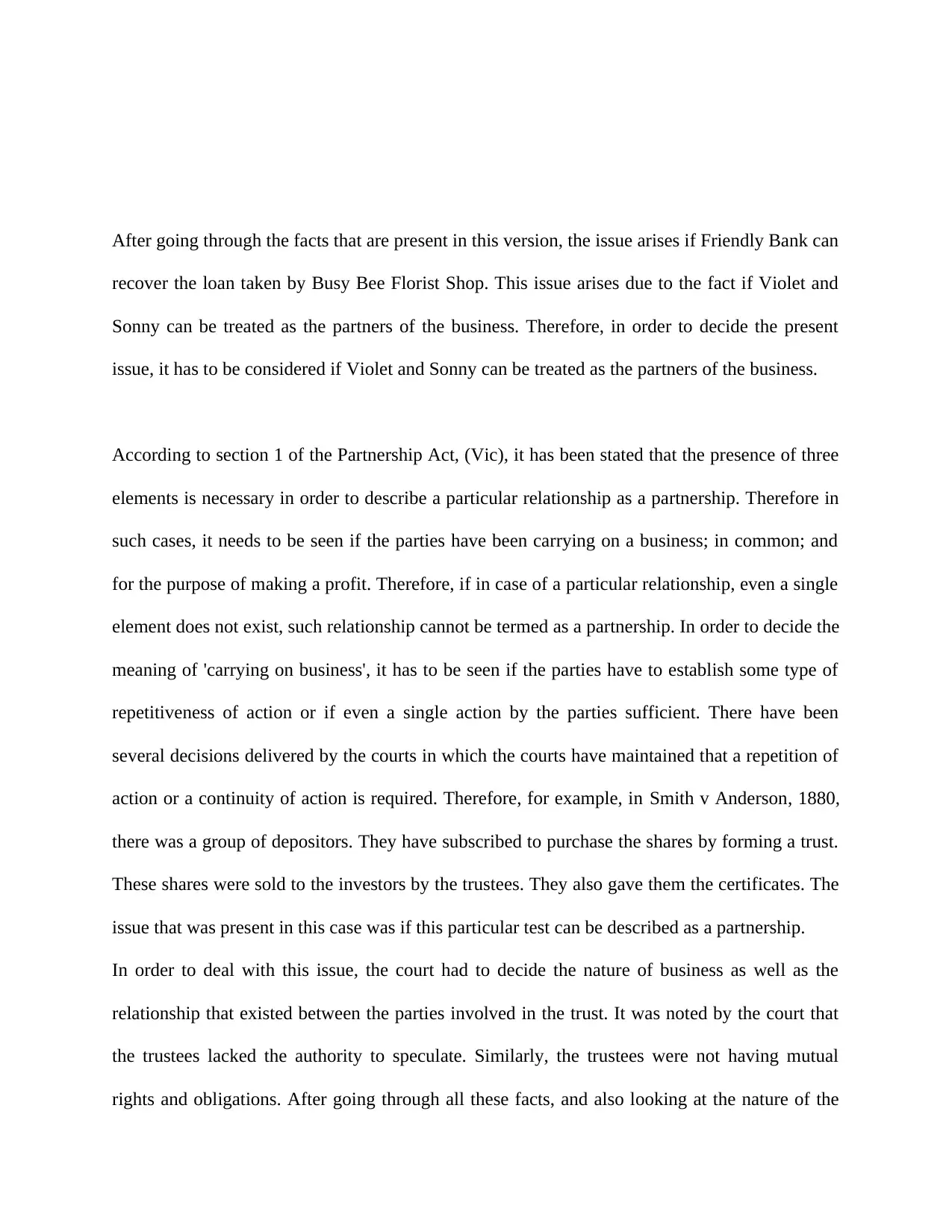
After going through the facts that are present in this version, the issue arises if Friendly Bank can
recover the loan taken by Busy Bee Florist Shop. This issue arises due to the fact if Violet and
Sonny can be treated as the partners of the business. Therefore, in order to decide the present
issue, it has to be considered if Violet and Sonny can be treated as the partners of the business.
According to section 1 of the Partnership Act, (Vic), it has been stated that the presence of three
elements is necessary in order to describe a particular relationship as a partnership. Therefore in
such cases, it needs to be seen if the parties have been carrying on a business; in common; and
for the purpose of making a profit. Therefore, if in case of a particular relationship, even a single
element does not exist, such relationship cannot be termed as a partnership. In order to decide the
meaning of 'carrying on business', it has to be seen if the parties have to establish some type of
repetitiveness of action or if even a single action by the parties sufficient. There have been
several decisions delivered by the courts in which the courts have maintained that a repetition of
action or a continuity of action is required. Therefore, for example, in Smith v Anderson, 1880,
there was a group of depositors. They have subscribed to purchase the shares by forming a trust.
These shares were sold to the investors by the trustees. They also gave them the certificates. The
issue that was present in this case was if this particular test can be described as a partnership.
In order to deal with this issue, the court had to decide the nature of business as well as the
relationship that existed between the parties involved in the trust. It was noted by the court that
the trustees lacked the authority to speculate. Similarly, the trustees were not having mutual
rights and obligations. After going through all these facts, and also looking at the nature of the
recover the loan taken by Busy Bee Florist Shop. This issue arises due to the fact if Violet and
Sonny can be treated as the partners of the business. Therefore, in order to decide the present
issue, it has to be considered if Violet and Sonny can be treated as the partners of the business.
According to section 1 of the Partnership Act, (Vic), it has been stated that the presence of three
elements is necessary in order to describe a particular relationship as a partnership. Therefore in
such cases, it needs to be seen if the parties have been carrying on a business; in common; and
for the purpose of making a profit. Therefore, if in case of a particular relationship, even a single
element does not exist, such relationship cannot be termed as a partnership. In order to decide the
meaning of 'carrying on business', it has to be seen if the parties have to establish some type of
repetitiveness of action or if even a single action by the parties sufficient. There have been
several decisions delivered by the courts in which the courts have maintained that a repetition of
action or a continuity of action is required. Therefore, for example, in Smith v Anderson, 1880,
there was a group of depositors. They have subscribed to purchase the shares by forming a trust.
These shares were sold to the investors by the trustees. They also gave them the certificates. The
issue that was present in this case was if this particular test can be described as a partnership.
In order to deal with this issue, the court had to decide the nature of business as well as the
relationship that existed between the parties involved in the trust. It was noted by the court that
the trustees lacked the authority to speculate. Similarly, the trustees were not having mutual
rights and obligations. After going through all these facts, and also looking at the nature of the
Paraphrase This Document
Need a fresh take? Get an instant paraphrase of this document with our AI Paraphraser
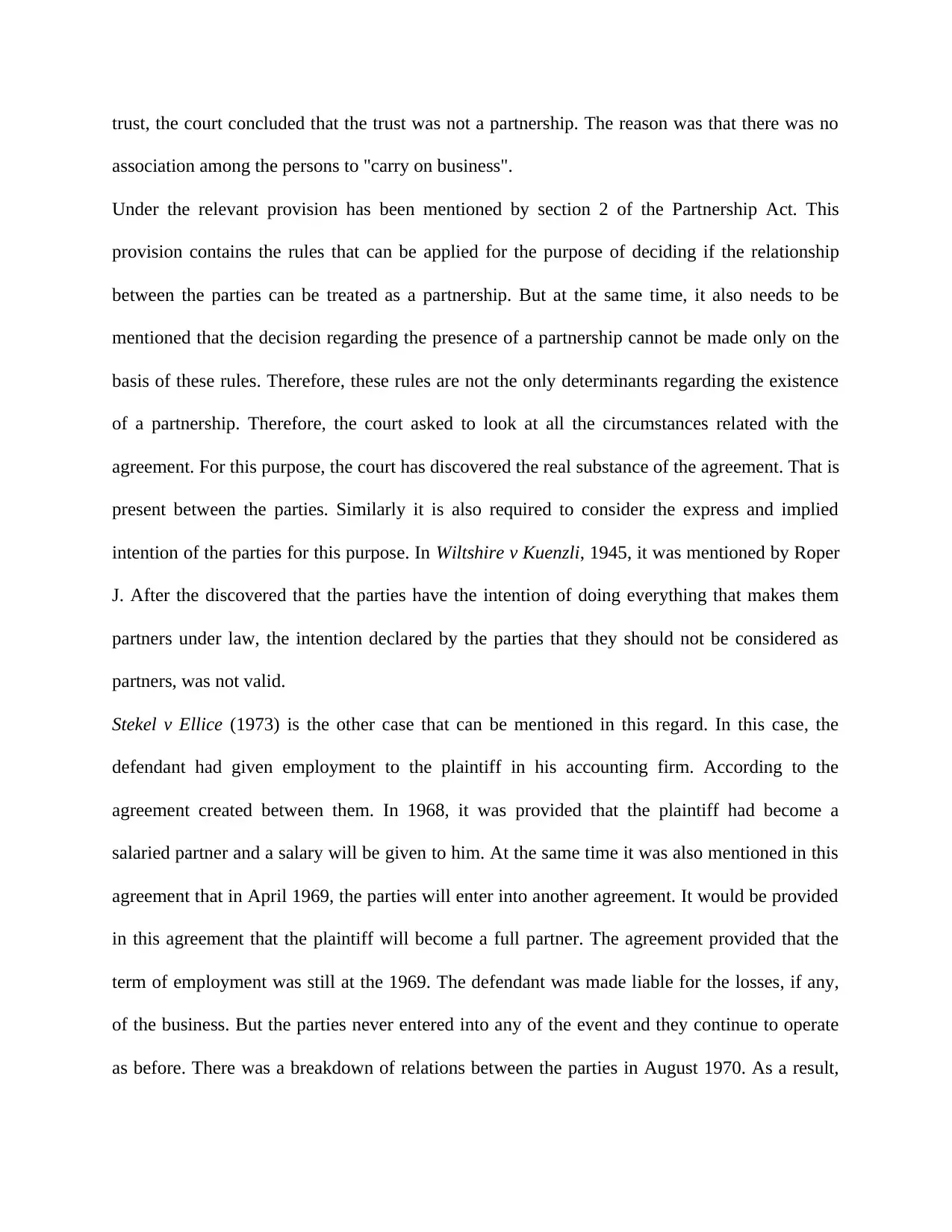
trust, the court concluded that the trust was not a partnership. The reason was that there was no
association among the persons to "carry on business".
Under the relevant provision has been mentioned by section 2 of the Partnership Act. This
provision contains the rules that can be applied for the purpose of deciding if the relationship
between the parties can be treated as a partnership. But at the same time, it also needs to be
mentioned that the decision regarding the presence of a partnership cannot be made only on the
basis of these rules. Therefore, these rules are not the only determinants regarding the existence
of a partnership. Therefore, the court asked to look at all the circumstances related with the
agreement. For this purpose, the court has discovered the real substance of the agreement. That is
present between the parties. Similarly it is also required to consider the express and implied
intention of the parties for this purpose. In Wiltshire v Kuenzli, 1945, it was mentioned by Roper
J. After the discovered that the parties have the intention of doing everything that makes them
partners under law, the intention declared by the parties that they should not be considered as
partners, was not valid.
Stekel v Ellice (1973) is the other case that can be mentioned in this regard. In this case, the
defendant had given employment to the plaintiff in his accounting firm. According to the
agreement created between them. In 1968, it was provided that the plaintiff had become a
salaried partner and a salary will be given to him. At the same time it was also mentioned in this
agreement that in April 1969, the parties will enter into another agreement. It would be provided
in this agreement that the plaintiff will become a full partner. The agreement provided that the
term of employment was still at the 1969. The defendant was made liable for the losses, if any,
of the business. But the parties never entered into any of the event and they continue to operate
as before. There was a breakdown of relations between the parties in August 1970. As a result,
association among the persons to "carry on business".
Under the relevant provision has been mentioned by section 2 of the Partnership Act. This
provision contains the rules that can be applied for the purpose of deciding if the relationship
between the parties can be treated as a partnership. But at the same time, it also needs to be
mentioned that the decision regarding the presence of a partnership cannot be made only on the
basis of these rules. Therefore, these rules are not the only determinants regarding the existence
of a partnership. Therefore, the court asked to look at all the circumstances related with the
agreement. For this purpose, the court has discovered the real substance of the agreement. That is
present between the parties. Similarly it is also required to consider the express and implied
intention of the parties for this purpose. In Wiltshire v Kuenzli, 1945, it was mentioned by Roper
J. After the discovered that the parties have the intention of doing everything that makes them
partners under law, the intention declared by the parties that they should not be considered as
partners, was not valid.
Stekel v Ellice (1973) is the other case that can be mentioned in this regard. In this case, the
defendant had given employment to the plaintiff in his accounting firm. According to the
agreement created between them. In 1968, it was provided that the plaintiff had become a
salaried partner and a salary will be given to him. At the same time it was also mentioned in this
agreement that in April 1969, the parties will enter into another agreement. It would be provided
in this agreement that the plaintiff will become a full partner. The agreement provided that the
term of employment was still at the 1969. The defendant was made liable for the losses, if any,
of the business. But the parties never entered into any of the event and they continue to operate
as before. There was a breakdown of relations between the parties in August 1970. As a result,
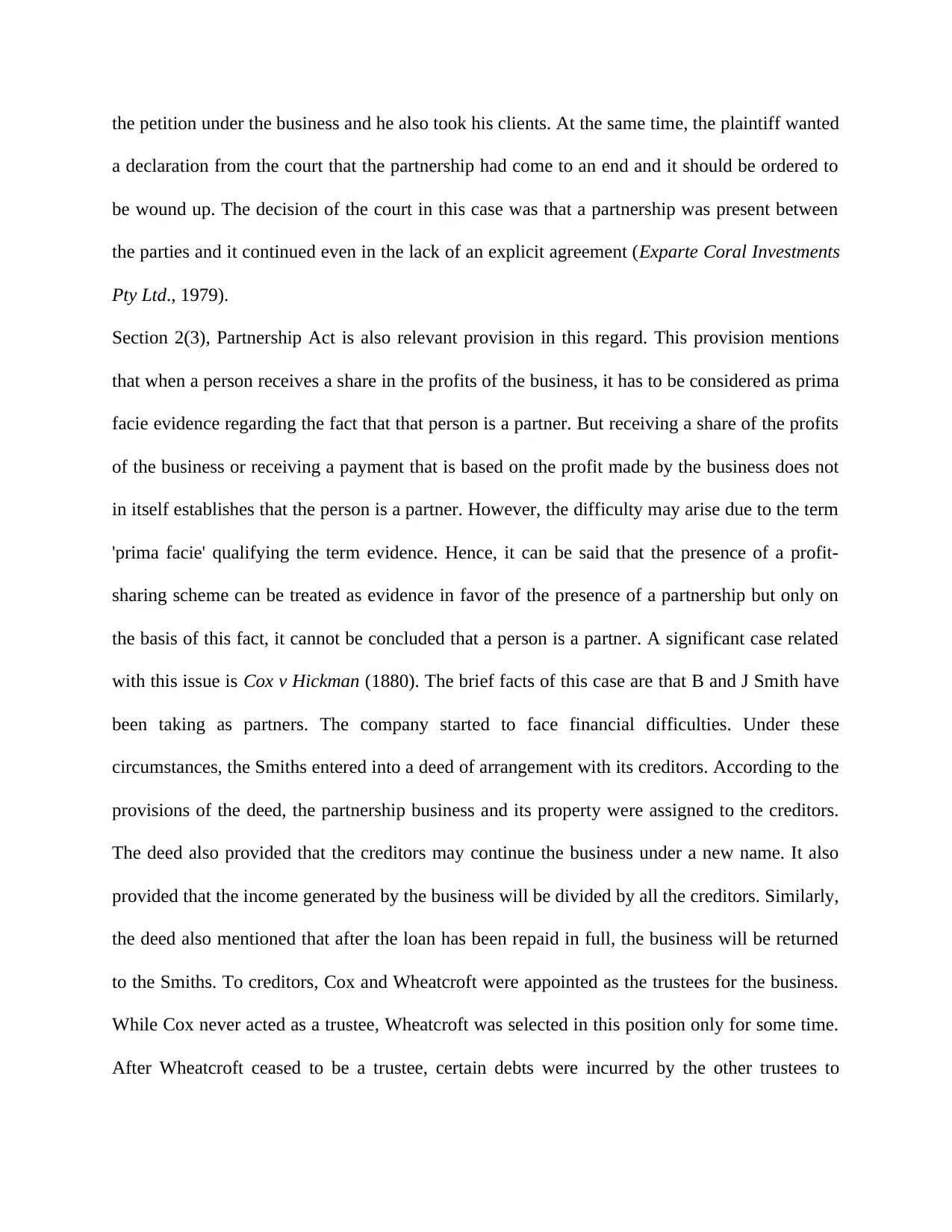
the petition under the business and he also took his clients. At the same time, the plaintiff wanted
a declaration from the court that the partnership had come to an end and it should be ordered to
be wound up. The decision of the court in this case was that a partnership was present between
the parties and it continued even in the lack of an explicit agreement (Exparte Coral Investments
Pty Ltd., 1979).
Section 2(3), Partnership Act is also relevant provision in this regard. This provision mentions
that when a person receives a share in the profits of the business, it has to be considered as prima
facie evidence regarding the fact that that person is a partner. But receiving a share of the profits
of the business or receiving a payment that is based on the profit made by the business does not
in itself establishes that the person is a partner. However, the difficulty may arise due to the term
'prima facie' qualifying the term evidence. Hence, it can be said that the presence of a profit-
sharing scheme can be treated as evidence in favor of the presence of a partnership but only on
the basis of this fact, it cannot be concluded that a person is a partner. A significant case related
with this issue is Cox v Hickman (1880). The brief facts of this case are that B and J Smith have
been taking as partners. The company started to face financial difficulties. Under these
circumstances, the Smiths entered into a deed of arrangement with its creditors. According to the
provisions of the deed, the partnership business and its property were assigned to the creditors.
The deed also provided that the creditors may continue the business under a new name. It also
provided that the income generated by the business will be divided by all the creditors. Similarly,
the deed also mentioned that after the loan has been repaid in full, the business will be returned
to the Smiths. To creditors, Cox and Wheatcroft were appointed as the trustees for the business.
While Cox never acted as a trustee, Wheatcroft was selected in this position only for some time.
After Wheatcroft ceased to be a trustee, certain debts were incurred by the other trustees to
a declaration from the court that the partnership had come to an end and it should be ordered to
be wound up. The decision of the court in this case was that a partnership was present between
the parties and it continued even in the lack of an explicit agreement (Exparte Coral Investments
Pty Ltd., 1979).
Section 2(3), Partnership Act is also relevant provision in this regard. This provision mentions
that when a person receives a share in the profits of the business, it has to be considered as prima
facie evidence regarding the fact that that person is a partner. But receiving a share of the profits
of the business or receiving a payment that is based on the profit made by the business does not
in itself establishes that the person is a partner. However, the difficulty may arise due to the term
'prima facie' qualifying the term evidence. Hence, it can be said that the presence of a profit-
sharing scheme can be treated as evidence in favor of the presence of a partnership but only on
the basis of this fact, it cannot be concluded that a person is a partner. A significant case related
with this issue is Cox v Hickman (1880). The brief facts of this case are that B and J Smith have
been taking as partners. The company started to face financial difficulties. Under these
circumstances, the Smiths entered into a deed of arrangement with its creditors. According to the
provisions of the deed, the partnership business and its property were assigned to the creditors.
The deed also provided that the creditors may continue the business under a new name. It also
provided that the income generated by the business will be divided by all the creditors. Similarly,
the deed also mentioned that after the loan has been repaid in full, the business will be returned
to the Smiths. To creditors, Cox and Wheatcroft were appointed as the trustees for the business.
While Cox never acted as a trustee, Wheatcroft was selected in this position only for some time.
After Wheatcroft ceased to be a trustee, certain debts were incurred by the other trustees to
⊘ This is a preview!⊘
Do you want full access?
Subscribe today to unlock all pages.

Trusted by 1+ million students worldwide
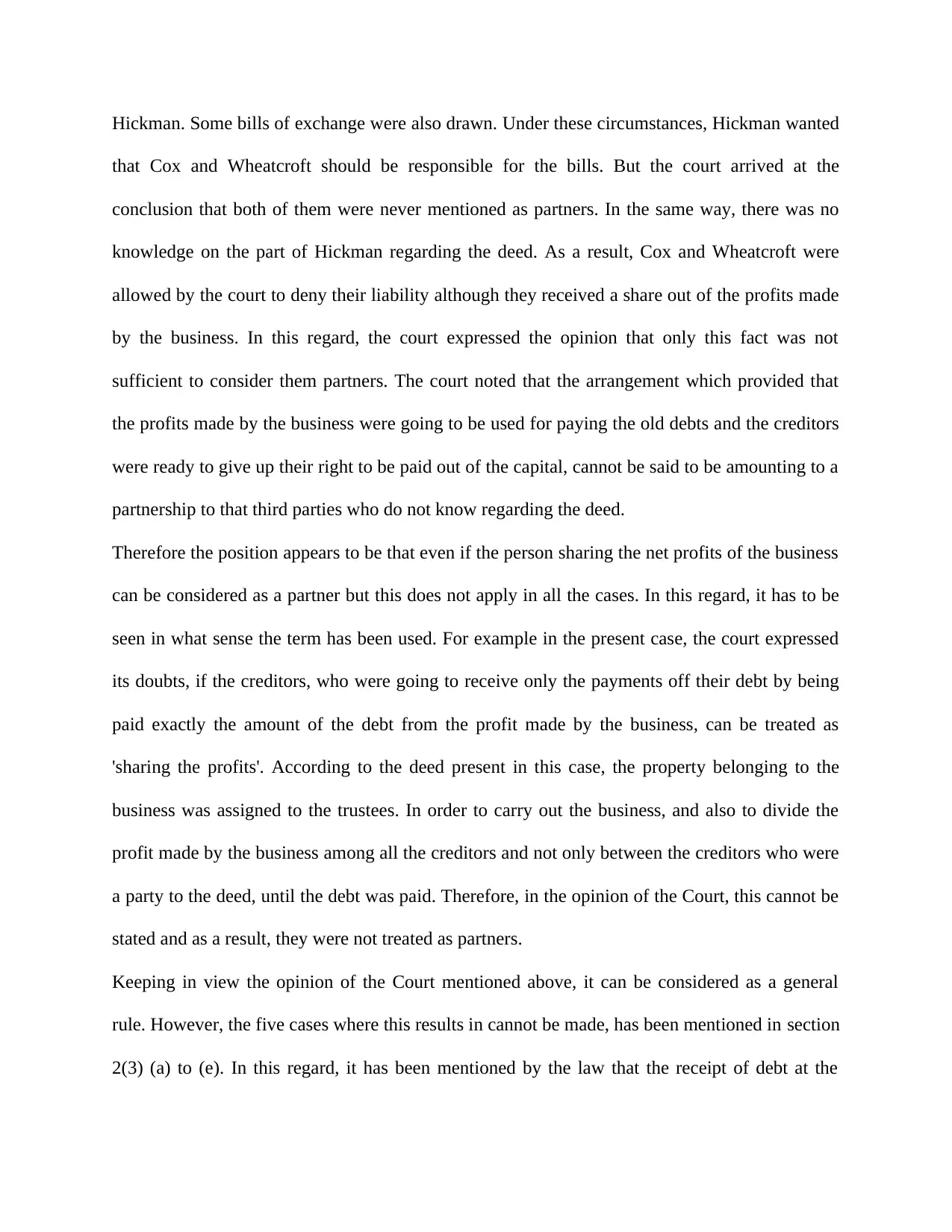
Hickman. Some bills of exchange were also drawn. Under these circumstances, Hickman wanted
that Cox and Wheatcroft should be responsible for the bills. But the court arrived at the
conclusion that both of them were never mentioned as partners. In the same way, there was no
knowledge on the part of Hickman regarding the deed. As a result, Cox and Wheatcroft were
allowed by the court to deny their liability although they received a share out of the profits made
by the business. In this regard, the court expressed the opinion that only this fact was not
sufficient to consider them partners. The court noted that the arrangement which provided that
the profits made by the business were going to be used for paying the old debts and the creditors
were ready to give up their right to be paid out of the capital, cannot be said to be amounting to a
partnership to that third parties who do not know regarding the deed.
Therefore the position appears to be that even if the person sharing the net profits of the business
can be considered as a partner but this does not apply in all the cases. In this regard, it has to be
seen in what sense the term has been used. For example in the present case, the court expressed
its doubts, if the creditors, who were going to receive only the payments off their debt by being
paid exactly the amount of the debt from the profit made by the business, can be treated as
'sharing the profits'. According to the deed present in this case, the property belonging to the
business was assigned to the trustees. In order to carry out the business, and also to divide the
profit made by the business among all the creditors and not only between the creditors who were
a party to the deed, until the debt was paid. Therefore, in the opinion of the Court, this cannot be
stated and as a result, they were not treated as partners.
Keeping in view the opinion of the Court mentioned above, it can be considered as a general
rule. However, the five cases where this results in cannot be made, has been mentioned in section
2(3) (a) to (e). In this regard, it has been mentioned by the law that the receipt of debt at the
that Cox and Wheatcroft should be responsible for the bills. But the court arrived at the
conclusion that both of them were never mentioned as partners. In the same way, there was no
knowledge on the part of Hickman regarding the deed. As a result, Cox and Wheatcroft were
allowed by the court to deny their liability although they received a share out of the profits made
by the business. In this regard, the court expressed the opinion that only this fact was not
sufficient to consider them partners. The court noted that the arrangement which provided that
the profits made by the business were going to be used for paying the old debts and the creditors
were ready to give up their right to be paid out of the capital, cannot be said to be amounting to a
partnership to that third parties who do not know regarding the deed.
Therefore the position appears to be that even if the person sharing the net profits of the business
can be considered as a partner but this does not apply in all the cases. In this regard, it has to be
seen in what sense the term has been used. For example in the present case, the court expressed
its doubts, if the creditors, who were going to receive only the payments off their debt by being
paid exactly the amount of the debt from the profit made by the business, can be treated as
'sharing the profits'. According to the deed present in this case, the property belonging to the
business was assigned to the trustees. In order to carry out the business, and also to divide the
profit made by the business among all the creditors and not only between the creditors who were
a party to the deed, until the debt was paid. Therefore, in the opinion of the Court, this cannot be
stated and as a result, they were not treated as partners.
Keeping in view the opinion of the Court mentioned above, it can be considered as a general
rule. However, the five cases where this results in cannot be made, has been mentioned in section
2(3) (a) to (e). In this regard, it has been mentioned by the law that the receipt of debt at the
Paraphrase This Document
Need a fresh take? Get an instant paraphrase of this document with our AI Paraphraser
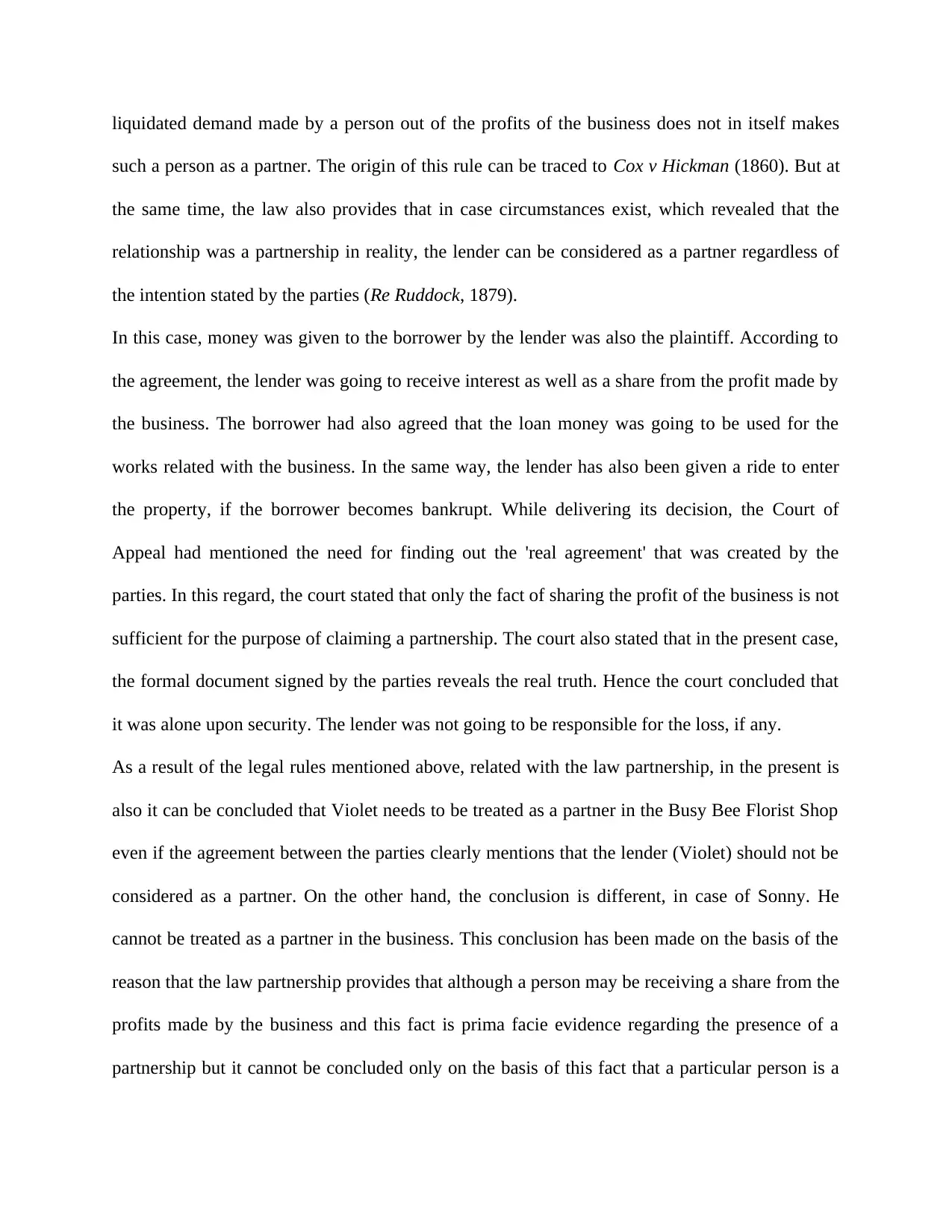
liquidated demand made by a person out of the profits of the business does not in itself makes
such a person as a partner. The origin of this rule can be traced to Cox v Hickman (1860). But at
the same time, the law also provides that in case circumstances exist, which revealed that the
relationship was a partnership in reality, the lender can be considered as a partner regardless of
the intention stated by the parties (Re Ruddock, 1879).
In this case, money was given to the borrower by the lender was also the plaintiff. According to
the agreement, the lender was going to receive interest as well as a share from the profit made by
the business. The borrower had also agreed that the loan money was going to be used for the
works related with the business. In the same way, the lender has also been given a ride to enter
the property, if the borrower becomes bankrupt. While delivering its decision, the Court of
Appeal had mentioned the need for finding out the 'real agreement' that was created by the
parties. In this regard, the court stated that only the fact of sharing the profit of the business is not
sufficient for the purpose of claiming a partnership. The court also stated that in the present case,
the formal document signed by the parties reveals the real truth. Hence the court concluded that
it was alone upon security. The lender was not going to be responsible for the loss, if any.
As a result of the legal rules mentioned above, related with the law partnership, in the present is
also it can be concluded that Violet needs to be treated as a partner in the Busy Bee Florist Shop
even if the agreement between the parties clearly mentions that the lender (Violet) should not be
considered as a partner. On the other hand, the conclusion is different, in case of Sonny. He
cannot be treated as a partner in the business. This conclusion has been made on the basis of the
reason that the law partnership provides that although a person may be receiving a share from the
profits made by the business and this fact is prima facie evidence regarding the presence of a
partnership but it cannot be concluded only on the basis of this fact that a particular person is a
such a person as a partner. The origin of this rule can be traced to Cox v Hickman (1860). But at
the same time, the law also provides that in case circumstances exist, which revealed that the
relationship was a partnership in reality, the lender can be considered as a partner regardless of
the intention stated by the parties (Re Ruddock, 1879).
In this case, money was given to the borrower by the lender was also the plaintiff. According to
the agreement, the lender was going to receive interest as well as a share from the profit made by
the business. The borrower had also agreed that the loan money was going to be used for the
works related with the business. In the same way, the lender has also been given a ride to enter
the property, if the borrower becomes bankrupt. While delivering its decision, the Court of
Appeal had mentioned the need for finding out the 'real agreement' that was created by the
parties. In this regard, the court stated that only the fact of sharing the profit of the business is not
sufficient for the purpose of claiming a partnership. The court also stated that in the present case,
the formal document signed by the parties reveals the real truth. Hence the court concluded that
it was alone upon security. The lender was not going to be responsible for the loss, if any.
As a result of the legal rules mentioned above, related with the law partnership, in the present is
also it can be concluded that Violet needs to be treated as a partner in the Busy Bee Florist Shop
even if the agreement between the parties clearly mentions that the lender (Violet) should not be
considered as a partner. On the other hand, the conclusion is different, in case of Sonny. He
cannot be treated as a partner in the business. This conclusion has been made on the basis of the
reason that the law partnership provides that although a person may be receiving a share from the
profits made by the business and this fact is prima facie evidence regarding the presence of a
partnership but it cannot be concluded only on the basis of this fact that a particular person is a
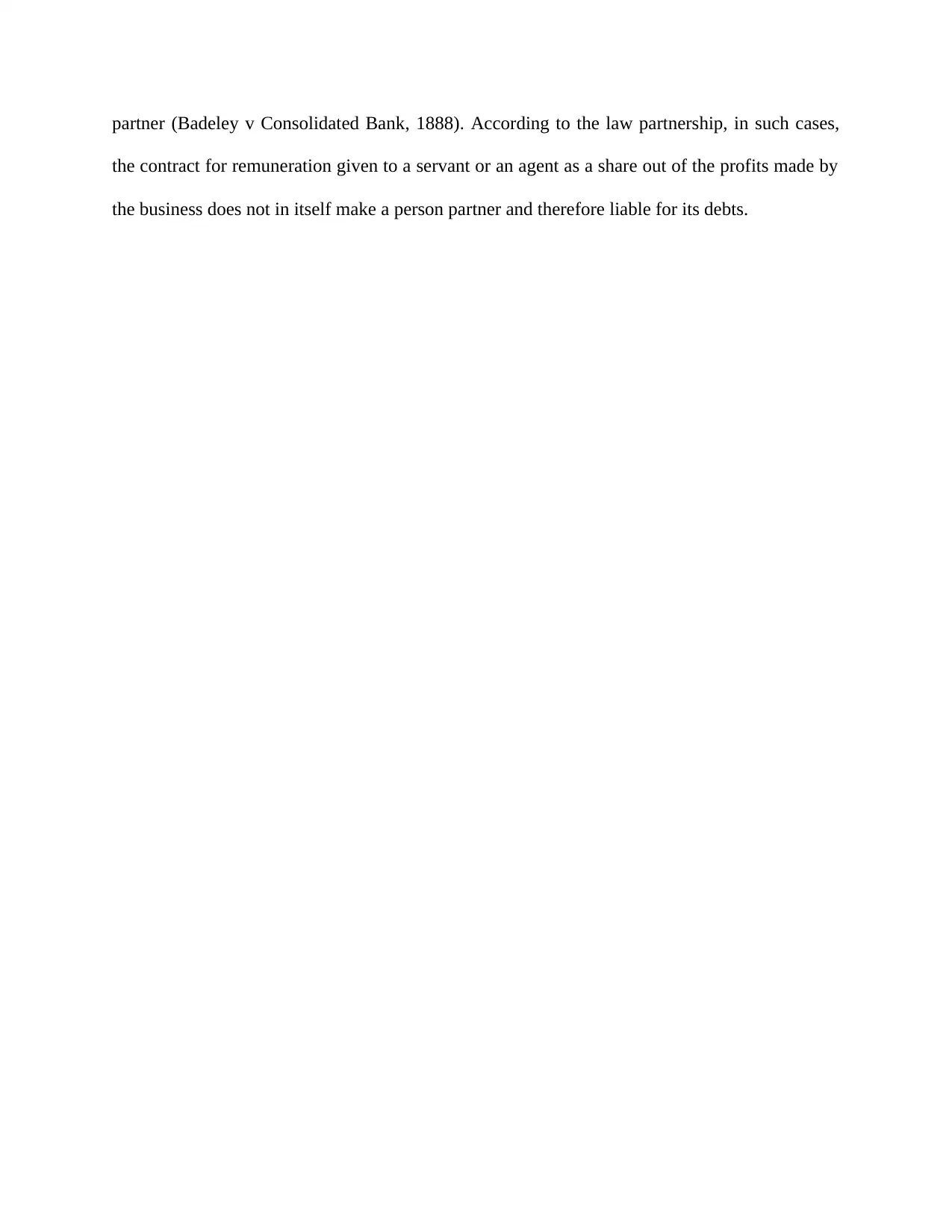
partner (Badeley v Consolidated Bank, 1888). According to the law partnership, in such cases,
the contract for remuneration given to a servant or an agent as a share out of the profits made by
the business does not in itself make a person partner and therefore liable for its debts.
the contract for remuneration given to a servant or an agent as a share out of the profits made by
the business does not in itself make a person partner and therefore liable for its debts.
⊘ This is a preview!⊘
Do you want full access?
Subscribe today to unlock all pages.

Trusted by 1+ million students worldwide
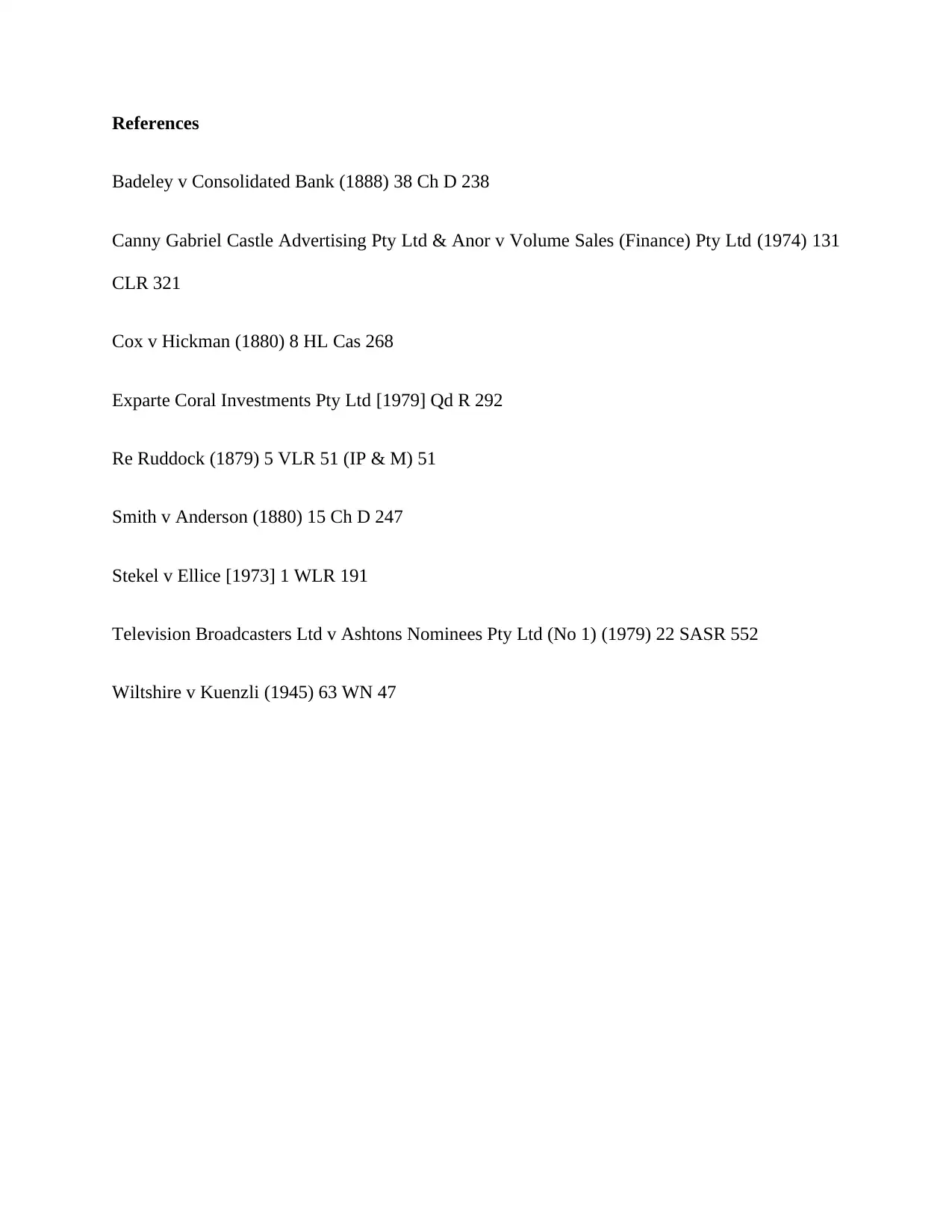
References
Badeley v Consolidated Bank (1888) 38 Ch D 238
Canny Gabriel Castle Advertising Pty Ltd & Anor v Volume Sales (Finance) Pty Ltd (1974) 131
CLR 321
Cox v Hickman (1880) 8 HL Cas 268
Exparte Coral Investments Pty Ltd [1979] Qd R 292
Re Ruddock (1879) 5 VLR 51 (IP & M) 51
Smith v Anderson (1880) 15 Ch D 247
Stekel v Ellice [1973] 1 WLR 191
Television Broadcasters Ltd v Ashtons Nominees Pty Ltd (No 1) (1979) 22 SASR 552
Wiltshire v Kuenzli (1945) 63 WN 47
Badeley v Consolidated Bank (1888) 38 Ch D 238
Canny Gabriel Castle Advertising Pty Ltd & Anor v Volume Sales (Finance) Pty Ltd (1974) 131
CLR 321
Cox v Hickman (1880) 8 HL Cas 268
Exparte Coral Investments Pty Ltd [1979] Qd R 292
Re Ruddock (1879) 5 VLR 51 (IP & M) 51
Smith v Anderson (1880) 15 Ch D 247
Stekel v Ellice [1973] 1 WLR 191
Television Broadcasters Ltd v Ashtons Nominees Pty Ltd (No 1) (1979) 22 SASR 552
Wiltshire v Kuenzli (1945) 63 WN 47
1 out of 7
Related Documents
Your All-in-One AI-Powered Toolkit for Academic Success.
+13062052269
info@desklib.com
Available 24*7 on WhatsApp / Email
![[object Object]](/_next/static/media/star-bottom.7253800d.svg)
Unlock your academic potential
Copyright © 2020–2025 A2Z Services. All Rights Reserved. Developed and managed by ZUCOL.





